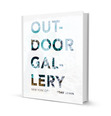Yoav Litvin's Blog, page 6
May 12, 2016
Radical and Anti-Imperialist Art on the Streets of Cuba
As a culture famous for its unique and developed arts and led by a staunch and long-time anti-American socialist regime, I was eager to wander the streets of Cuba’s cities in search for political art. Here are some gems:
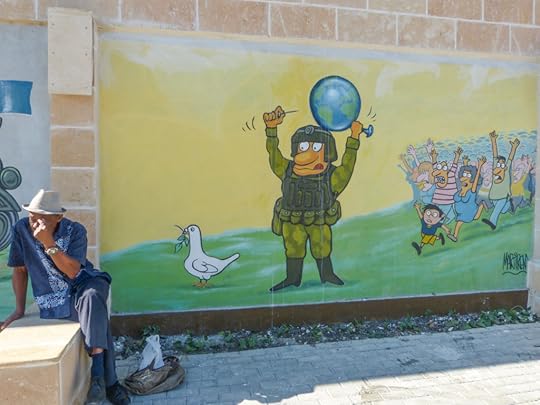
Art by Martirena
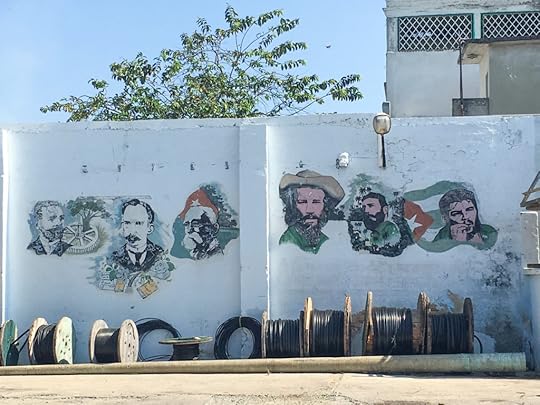
Famous Cubans immortalized (from right: Guillermo Moncada, Jose Marti, Felix Varela, Camilo Cienfuegos, Fidel Castro, Che Guevara)

Art by Linares

Art by Adano

Art by Roland William Ale

Che Guevara and Hugo Chavez looking up at Simon Bolivar
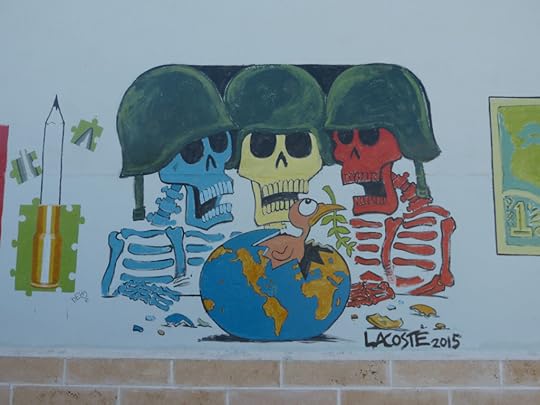
Art by Lacoste
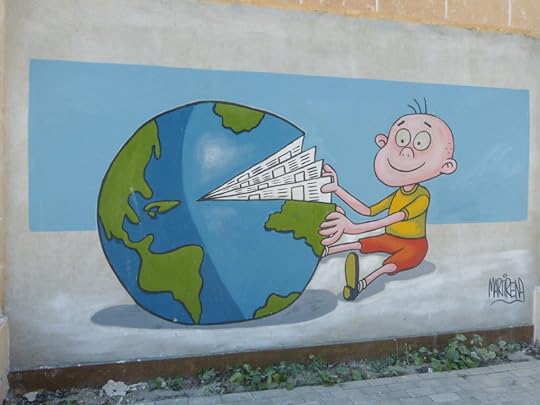
Art by Martirena
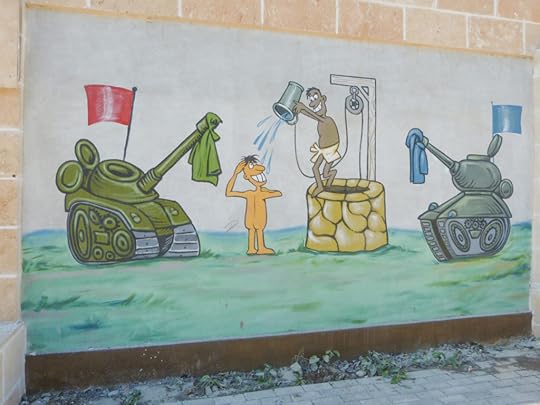
Unknown artist
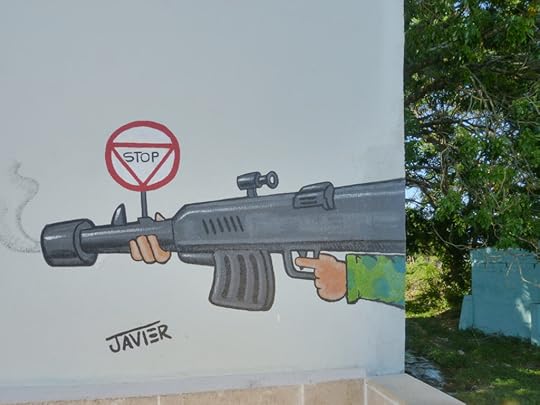
Art by Javier
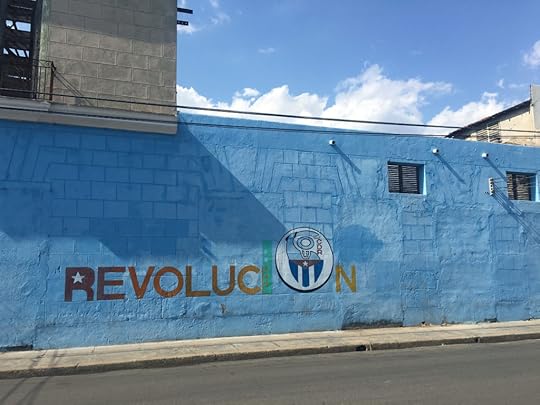
Cuban revolutionary propaganda

Art by Linares

Art by Feddor
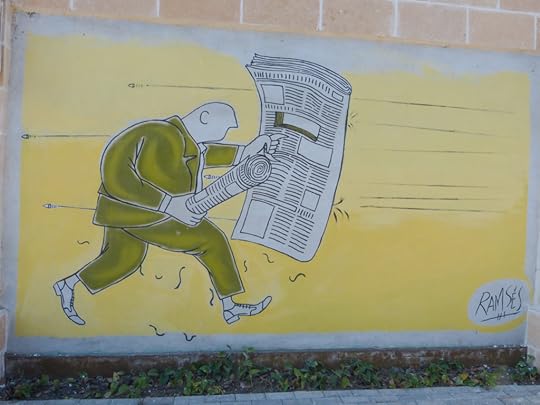
Art by Ramses

Art by Lacoste
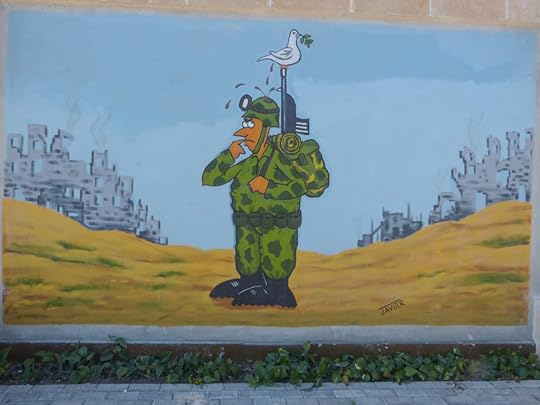
Art by Javier

Art by Osval and Andez
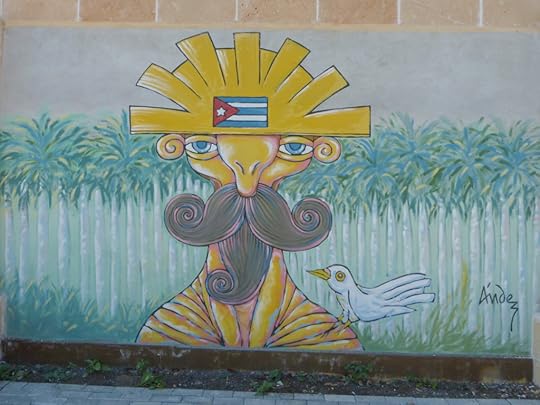
Art by Andez
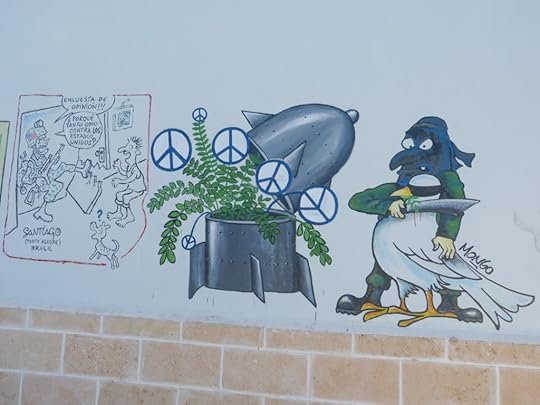
Art by Mongo and Santiago
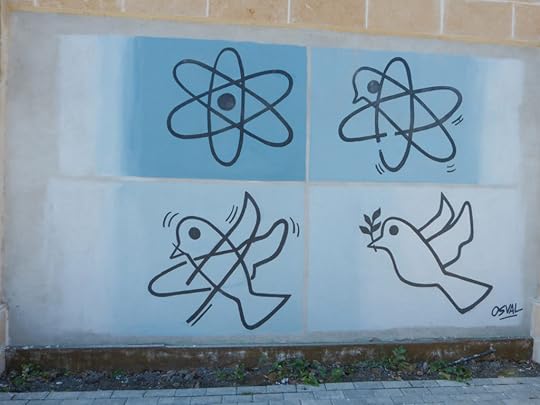
Art by Osval

Stencil featuring a modern version of the spread of the Cuban revolution
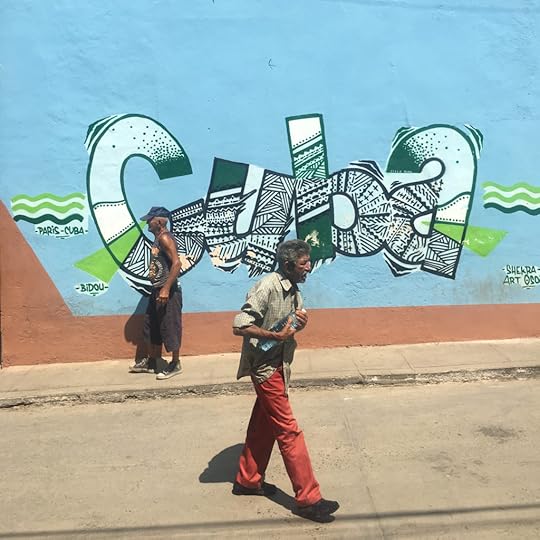
Art by Shekra
The post Radical and Anti-Imperialist Art on the Streets of Cuba appeared first on Yoav Litvin.
April 8, 2016
Bernie Sanders at Home
East 26th and Avenue P looks like a typical street corner in the Flatbush neighborhood of Brooklyn, New York City. During the middle of the day it is mostly abandoned. Perhaps if you hang out for a while you can spot an old man walking by, cars trudging along, a mother dragging her two whiny children, an orthodox Jew meandering, or kids shuffling out of James Madison High School, laughing, playing, yelling, daydreaming.
But today was not a regular day. At high noon, on this cloudy and frigid April day the corner was teeming with thousands of people of all ages and backgrounds; talking, laughing, debating, singing, and of course hugging (for free!). They were all patiently and proudly waiting for their hood’s celebrity: Bernie Sanders.
Here are some photos from today’s events on East 26th and Avenue P, Flatbush, Brooklyn:

Thousands on line waiting for Brooklyn’s own Bernie Sanders

Free Hugs

NYPD in a tour de force
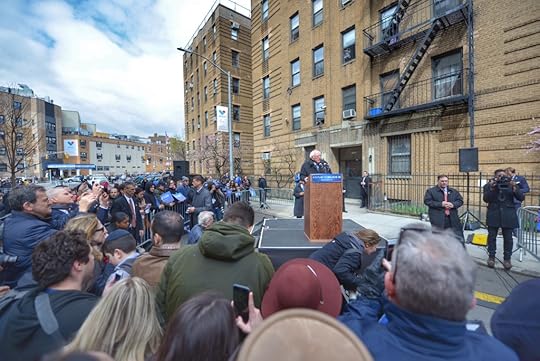
Bernie Sanders in Brooklyn
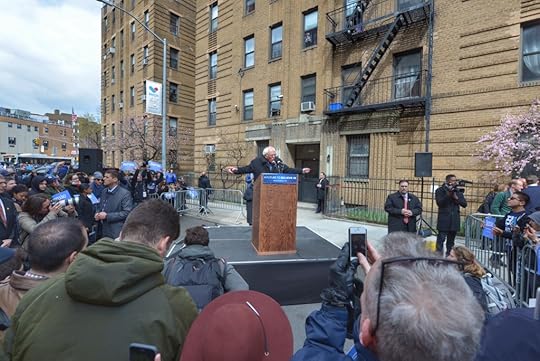
Bernie Sanders in Brooklyn
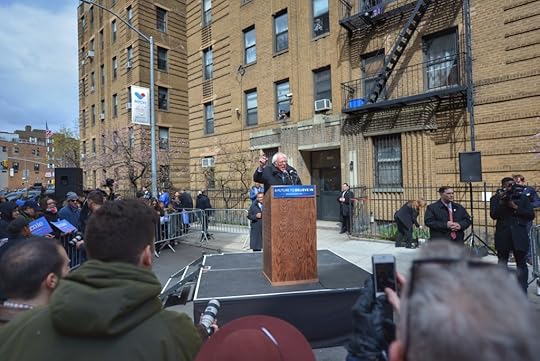
Bernie Sanders in Brooklyn
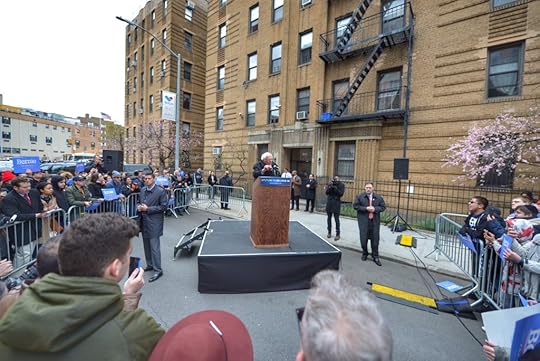
Bernie Sanders in Brooklyn

Bernie Sanders in Brooklyn
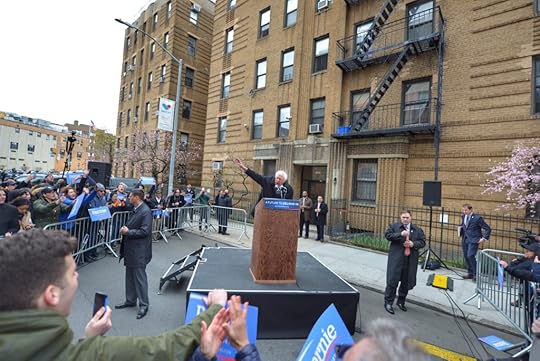
Bernie Sanders in Brooklyn
Check out a part of Bernie’s speech:
All photos and video copyright Yoav Litvin
The post Bernie Sanders at Home appeared first on Yoav Litvin.
October 2, 2015
New York in the 80s: an Ode to Realism
It’s been almost 30 years since the 80s and lots has changed. Nowadays, the city is a playground for the rich and a symbol of gentrification. Everything is regulated and supervised. Artists and independents move farther and farther into the periphery, with New Jersey being the latest frontier; a stinging testament to the ongoing loss of New York’s original character.
With the passage of time people seem to idealize the past while subconsciously repressing some of its bitter realities and forgetting its hard won lessons. Some insist the 80s symbolize the American Dream and not its nightmare. There are those who even use words like “cool” and “real” to describe New York in the 80s. They conflate that period of moral and financial bankruptcy with the incredible creative resistance that bloomed during its tenure and in spite of the enormous pushback by city hall, the police department, the MTA and mainstream media. Luckily for us, hip-hop, graffiti and break dancing have prevailed while the 80s, well, are past. Back then New York was a scary, violent town plagued by poverty, racism, severe inequality, and was downright rotten with corruption.
I remember the fear of having to walk across Central Park right after hearing about a rape or assault that went down the night before; or when my teacher told us about our schoolmate who got shot in the shoulder on 93rd and Broadway. “He got in the middle of a beef between two drunks. He can only blame himself.”
I remember Times Square was home to endless strip clubs, peep shows and sex shops. Sidewalks bustling with a mishmash of middle aged men from the suburbs, hookers, flashy pimps, beggars and underage girls and boys, most likely runaways.
I remember in the mornings I was greeted by a surreal combo of a grinning Tony the Tiger and pictures of kidnapped boys and girls on my milk carton, some missing for years, most lost forever. Back then I only talked to people I knew.
I remember that Monday in ’87 when the stock market crashed. Fortunes lost, dreams vaporized. People jumped out of windows while others suddenly collapsed on Subway platforms, their hearts broken beyond repair. Deaths so violent that attempts at revival were frowned upon.
Back in the 80s New Yorkers had a global reputation for their toughness. New Yorkers never helped anyone. New Yorkers only looked out for number 1. New Yorkers were proud of it.
I remember those long silent rides on the Subway during rush hour; straphangers jam-packed like sardines. The silence deafening. The smell of fear unmistakable. Back then we had no pleasant automated voice telling us to stand clear of the closing doors, or that we are delayed because of train traffic ahead. We stood there, motionless, wearily avoiding any eye contact with fellow passengers. News reports of someone stabbed for staring at the wrong guy were too fresh in our minds. The train would frequently and randomly stop between stations for minutes on end. Inside, the lights would flicker and finally die out, triggering a panic of shuffling hands racing to secure any prized possessions from the pickpockets who were patiently waiting for their moment. Along the route we’d see abandoned stations that were converted into improvised shelters for society’s outcasts: the homeless, the ill, the forsaken, all sleeping in cardboard boxes surrounded by broken glass, trash, mangy rats and used needles. A scene reminiscent of Hugo’s Les Miserables, Big Apple style. Out in the station while beggars, war vets, starving mothers, drug addicts and runaways were beaten up for pocket change or for their “Real estate”, businessmen and women scurried to work turning their heads away, scared and indifferent.
So no, I don’t look back and reminisce about how “cool” the 80s were. When I do look back, it’s to learn for the future. It is to remind myself of the brave sacrifices artists, activists, intellectuals, radicals and free thinkers made for their work, art and ideals in spite of the hard times. Their resistance to those in power is what gave New York City its color and character.
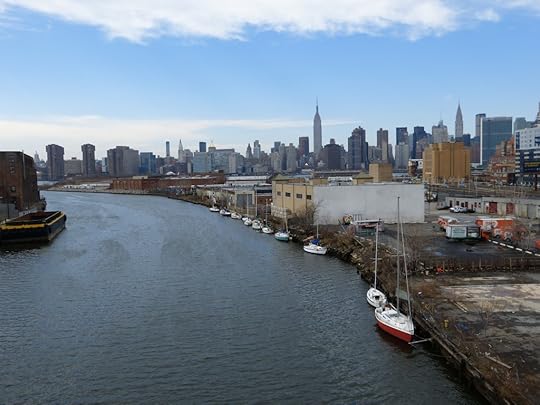
New York City from Pulaski Bridge
The post New York in the 80s: an Ode to Realism appeared first on Yoav Litvin.
New York in the 80s: an Ode to Romanticism
It’s been almost 30 years since the 80s and lots has changed. Nowadays, the city is a playground for the rich and a symbol of gentrification. Everything is regulated and supervised. Artists and independents move farther and farther into the periphery, with New Jersey being the latest frontier; a stinging testament to the ongoing loss of New York’s original character.
With the passage of time people seem to idealize the past while subconsciously repressing some of its bitter realities and forgetting its hard won lessons. Some insist the 80s symbolize the American Dream and not its nightmare. There are those who even use words like “cool” and “real” to describe New York in the 80s. They conflate that period of moral and financial bankruptcy with the incredible creative resistance that bloomed during its tenure and in spite of the enormous pushback by city hall, the police department, the MTA and mainstream media. Luckily for us, hip-hop, graffiti and break dancing have prevailed while the 80s, well; are past. Back then New York was a scary, violent town plagued by poverty, racism, severe inequality, and was downright rotten with corruption.
I remember the fear of having to walk across Central Park right after hearing about a rape or assault that went down the night before. Or when my teacher told us about our schoolmate who got shot in the shoulder on 93rd and Broadway. “He got in the middle of a beef between two drunks. He can only blame himself.”
I remember Times Square was home to endless strip clubs, peep shows and sex shops. Sidewalks bustling with a mishmash of middle aged men from the suburbs, hookers, flashy pimps, beggars and underage girls and boys, most likely runaways.
I remember in the mornings I was greeted by a surreal combo of a grinning Tony the Tiger and pictures of kidnapped boys and girls on my milk carton, some missing for years, most lost forever. Back then I only talked to people I knew.
I remember that Monday in ’87 when the stock market crashed. Fortunes lost, dreams vaporized. People jumped out of windows while others suddenly collapsed on Subway platforms, their hearts broken beyond repair. Deaths so violent that attempts at revival were frowned upon.
Back in the 80s New Yorkers had a global reputation for their toughness. New Yorkers never helped anyone. New Yorkers only looked out for number 1. New Yorkers were proud of it.
I remember those long silent rides on the Subway during rush hour; straphangers jam-packed like sardines. The silence deafening. The smell of fear unmistakable. Back then we had no pleasant automated voice telling us to stand clear of the closing doors, or that we are delayed because of train traffic ahead. We stood there, motionless, wearily avoiding any eye contact with fellow passengers. News reports of someone stabbed for staring at the wrong guy were too fresh in our minds. The train would frequently and randomly stop between stations for minutes on end. Inside, the lights would flicker and finally die out, triggering a panic of shuffling hands racing to secure any prized possessions from the pickpockets who were patiently waiting for their moment. Along the route we’d see abandoned stations that were converted into improvised shelters for society’s outcasts: the homeless, the ill, the forsaken, all sleeping in cardboard boxes surrounded by broken glass, trash, mangy rats and used needles. A scene reminiscent of Hugo’s Les Miserables, Big Apple style. Out in the station while beggars, war vets, starving mothers, drug addicts and runaways were beaten up for pocket change or for their “Real estate”, businessmen and women scurried to work turning their heads away, scared and indifferent.
So no, I don’t look back and reminisce about how “cool” the 80s were. When I do look back, it’s to learn for the future. It is to remind myself of the brave sacrifices artists, activists, intellectuals, radicals and free thinkers made for their work, art and ideals. Their resistance is what gave New York City its color and character.

New York City from Pulaski Bridge
The post New York in the 80s: an Ode to Romanticism appeared first on Yoav Litvin.
August 25, 2015
Trauma and Healing in Ethnic Conflicts; a Scientific Analysis of the Israeli-Palestinian Relationship
An approach designated as “evolutionary” can be employed in reference to two outlooks on global ethnic conflicts in general, and the Israeli/Palestinian one in particular. A Conservative and Neo-Liberal interpretation of Darwinism employs an approach whereby only the strongest peoples survive in a multi ethnic land. This so–called “survival of the fittest”, exclusionist outlook necessarily invokes in populations a chronic state of vigilance, defense, fear of the “other” and consequent suspicion and aggression. We see such ideology fostered by governments that instill competitive and exclusivist ideology in their populations through nurture of fear. This in turn facilitates the governments’ own self-interest political and economic agendas of empowerment and control. Fear is a cheap and efficient way to manipulate people, especially victims of trauma, as investment is unnecessary – our brains are hardwired to feel fear.
A progressive interpretation of evolution, on the other hand, emphasizes the adaptive utility of focus on mutual interests, inclusion, and co-operation. It endorses education for dialogue and reconciliation, and stresses the importance of equality for peace. Education necessarily requires investment and is thus initially costly. However, in the long run it pays off in the form of productivity, stability and welfare. A methodical understanding of brain mechanisms associated with fear, aggression and trauma may benefit our efforts to comprehend the persistence of conflict and ultimately formulate strategies for its resolution. Healing of trauma is the first step toward an inclusive and co-operative society based on equality.

Palestinian man with his son and donkeys wearing a shirt from Hebron, an Israeli settlement (Photo by Gilad Litvin)
Fear is an emotion crucial to survival. Thus, brain mechanisms that regulate fear are evolutionarily conserved in all mammals including humans. As such, research on mechanisms of fear in mammalian species such as mice and rats, affords the opportunity to learn about equivalent neural systems in humans.
In a laboratory setting, an animal can be taught to fear a particular cue using a method termed “fear conditioning”. Conditioning entails the presentation of an aversive stimulus, such as a loud noise or an electric shock along with a neutral cue, such as a light or musical tone. As a result of conditioning, the animal forms an association between the aversive stimulus and the neutral cue. Consequently, a cue that was once neutral evokes fear in the trained animal. The amygdala is the key brain structure wherein a synaptic connection is created between neurons of the neutral cue and those of the aversive stimulus. These principles of fear conditioning apply to humans as well.
The complex and dynamic human brain is able to perform unique functions that lead to fantastic accomplishments such as the composition of elaborate symphonies, reaching the moon and cracking the atom. However, the ability to inhibit and ultimately transcend fear is not a distinctly human capacity. In fact, the ability to transcend fear is easily observed in many mammals, including rats and mice in a laboratory. In order to extinguish the association between cues and emotions, one needs to decouple the stimuli; i.e. repeatedly expose the trained animal to the neutral cue without the presence of the aversive stimulus, a process termed “extinction of fear”. Research has shown that in extinction, neural projections from the prefrontal cortex inhibit fear-related activity in the amygdala. Human research shows that the functional capacity of the prefrontal cortex is strengthened by education.
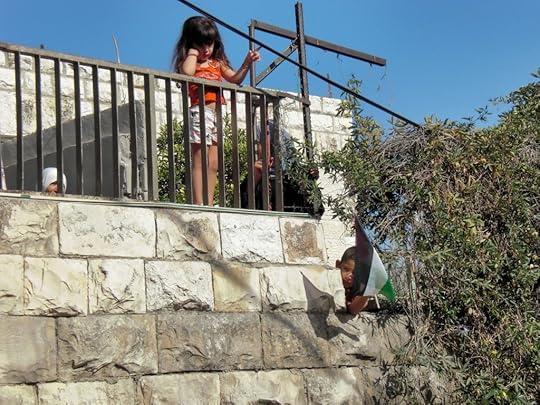
Palestinian Children in Silwan, Jerusalem
Importantly, even when treatment is successful, the neural pathway that associates a cue with fear will always exist in that particular animal or human though it may be inhibited. Thus, even after inhibiting a fearful association by use of re-exposure therapy, if the animal or human is re-exposed to the aversive stimulus, it will again exhibit fear toward the neutral stimulus. This process is termed “reinstatement”.
We can apply this simple behaviorist approach to our understanding of conflicts in general, and the Israeli-Palestinian conflict in particular. As societies, Israelis and Palestinians are in an abusive relationship. Interestingly, studies in both animals and humans suggest that one who is at present an abuser was more than likely abused in the past, probably during early life. The state of Israel is a home for scores of traumatized individuals, whether as a result of some anti-Semitic persecution, or a regional conflict. As such, the populace can be seen as inherently post-traumatic, prone to defensive, aggressive and impulsive behaviors typical of victims of trauma. The political, religious, military and economic elites in Israel easily manipulate these fear-based emotions in the populace to gain support for their aggressive, expansionist policies and to suppress dissent. It is easy; neural mechanisms of fear are present in all humans and can be reinstated at will in traumatized individuals. In fact, traumatized war veterans exhibit changes in the brain where the amygdala becomes primed and the prefrontal cortex is compromised, rendering them prone to find fear in everything. The Israeli government and media outlets persistently portray the Palestinian side as a threat to the very existence of Israelis, the so-called “demographic threat”. When tensions between Jewish Israelis and Palestinians subside, or Israeli social issues take center stage, the easiest way for the government to regain control is to reinstate fear. This can be accomplished by one of several methods: focusing on an act of Palestinian violence or resistance; reminding the public of some atrocity in the past (the Israeli calendar is full of memorial days) and; shifting attention to perceived threats, e.g. a nuclear Iran. Similar tactics are used by Hamas on the Palestinian side, albeit without the plentiful of resources available to the Israeli government. Lastly, the physical segregation of Israelis and Palestinians by the separation wall renders re-exposure that may lead to reconciliation virtually impossible.
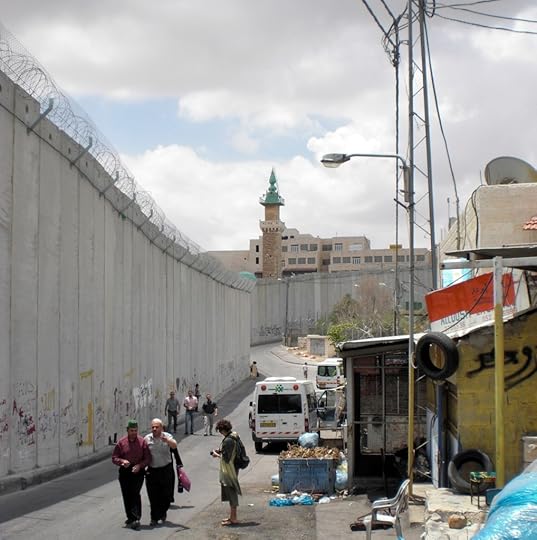
The separation wall between Jerusalem and Bethlehem
Any plan for a peaceful future must incorporate a process of dialogue toward reconciliation, an education system that uncompromisingly promotes historical truth, as well as the creation of relationships through shared acts of solidarity and civilian resistance to occupation. Nonetheless and for several generations, both sides will always need to maintain constant mindfulness and caution of the possibility of reinstatement. Ultimately, after several generations of peace the fear of the other will have been permanently extinguished and Israelis and Palestinians can coexist in a society that emphasizes empathy and cooperation.
All photos copyright Yoav Litvin
The post Trauma and Healing in Ethnic Conflicts; a Scientific Analysis of the Israeli-Palestinian Relationship appeared first on Yoav Litvin.
August 12, 2015
Facebook Thinks We’re All Rats
I run a couple of Facebook “Pages”. Every time I post something to a page, I see a button at the bottom of the post that reads: “Boost your Post”. For a minimal investment of $10 (though the sky is the limit), Facebook promises you the efficiency and glory of your own PR firm- they will promote your post, i.e. “Boost” it, to thousands of people who would otherwise not see it, the number of which depends on the sum you spend, of course. One can define a target demographic, age etc. It’s all pretty creepy.
I was always curious, but never tempted to “Boost” anything out of unwillingness to part with $10 for freaking Facebook likes. If someone is interested they will reach it, I reasoned. Last night I decided to test what Facebook’s “Boost” is really worth. I paid $10 to boost a post on my Outdoor Gallery Facebook Page of an article I wrote last week. In this article, I discuss the challenges artists face when working with large entities and the morality of their decisions, i.e. deconstructing the term “selling out”, and devised a very simple approach to tackle this question. The article is largely philosophical and not necessarily a light read. Because my article, like this one, is a blog post on my personal website, I can use “Google Analytics” to see the number of people visiting the article’s webpage. And so I decided to run my little experiment with the goal that my article reaches many readers. I would be able to gage this using two indications:
1) I’d see a spike in the number of visitors to the article’s webpage on my site using Google Analytics.
2) If the post indeed reached people and not robots, some would engage in meaningful discussion about it on my Facebook or blog post threads.
Rats will press a lever for reward: food or cocaine for example. This experimental technique termed Operant Conditioning was widely utilized by B.F. Skinner in his studies using pigeons, and it is still used to study reward pathways in the brain, especially in studies of drug addiction. Simply stated, Operant Conditioning is a learning process whereby a behavior is dictated by its consequences: if a rat presses a lever and immediately afterwards receives some cocaine, or a food pellet, the lever-pressing behavior is reinforced and the rat will do it more often. These neural systems have evolved to ensure survival by promoting behaviors associated with reward and are preserved in humans. Today we know much of the neural circuitry involved in reward pathways, the key role of many neurotransmitters in these processes (Dopamine being the most widely researched), and how these pathways can operate to reinforce behavior.
And now to the results of my experiment. I woke up this morning to a whopping 315 Likes on my “boosted” Facebook post. However, when I checked actual traffic to the article’s page on Google Analytics it had not spiked at all- in fact, the change from yesterday to today was not different than on any other day. Also- there were no new comments on any thread, showing absolutely no engagement (indicator 2 above)- which was the goal of my “boost”.
Facebook did a good job learning the techniques of Operant Conditioning used to manipulate rats’ behavior. As social animals, we humans seek attention and social acceptance and find it rewarding. Facebook understands that well, and that is the secret to their “Boost” money scam. They recognize that the behavior of “Liking” leads to reward and therefore it is reinforced. Meaning- “Liking” is akin to a rat’s lever pressing, and our feeling of social acceptance is the rewarding rush of cocaine, or a tasty meal.
Conclusion- To people who seek more than a rat’s reward i.e. immediate gratification, “Boosting” is a complete waste of money.
The post Facebook Thinks We’re All Rats appeared first on Yoav Litvin.
July 30, 2015
The Artist’s Dilemma: Who is a sellout?
The prisoner’s dilemma (developed by Flood, Dreshner and Tucker) is an analysis using game theory of a hypothetical situation whereby the police apprehend two accomplices for committing a minor crime. They are suspected of a greater offense, but the evidence is circumstantial and the police need their confession to convict. For this purpose the accomplices are separated and individually presented with the following options: squeal on your partner and go free (and be absolved of the lesser crime) OR remain silent and risk your partner squealing on you, in which case you get the maximal prison term for the major offense (e.g. 3 years in jail). But there are two more possible scenarios: if both prisoners squeal, they each get an intermediate sentence (e.g. 2 years). Lastly, if both prisoners stay silent, they will be tried for the lesser offense (e.g. 1 year in jail). Studies show that although game theory predicts that the rational choice (i.e. dictated by self preservation) for each prisoner is to squeal on his/her mate rather than choosing to cooperate (which is the best choice for the group), most humans will attempt to at least cooperate once before squealing, demonstrating the innate social tendencies of humans. See a video demonstrating the prisoner’s dilemma here.
Well, how is this rational analysis relevant to the art world? With the increased cooperation between commercial corporations and street artists, I’ve repeatedly asked myself: is this or that artist a “sellout”? Being called a “sellout” is the end-all-be-all curse for artists who consider themselves more than just technicians- those who claim to stand for something greater than mere financial gain. Intellectuals, academics and artists have historically been paramount in challenging, preserving and defending the morality of choices in human societies worldwide. Artists can use their work as a means to communicate messages of dissent and hope in the face of injustice, repression and despair. As such, artists have a duty to educate themselves with a moral conviction that warrants a quest for truth above all, irrespective of blind loyalties to friends or sociopolitical affiliation. Those who wish to control public opinion typically consider this untethered freedom of thought and expression a threat.
It’s hard to survive in today’s capitalist world as a full-time artist. The art market is very competitive, many say corrupt, promoting some over others due to personal relationships rather than skill level. Artists need to be industrious in order to survive and often cooperate with larger entities such as organizations and corporations. Here, I claim, lies “The Artist’s Dilemma”: How to effectively cooperate with a large entity while ensuring ones moral ground. Or in other words- what is “selling out”? Let’s try to apply a similar approach (in the form of a rational analysis) of that used in the prisoner’s dilemma, to this important question.
With moral presumptions come responsibilities. The principal duty of any artist with moral presumptions who chooses to cooperate with larger entities is to research their agendas. In today’s world this includes research on the Internet, but also communicating with the entity itself, and investigating what it stands for and against. If after adequate research, the entity’s agenda coincides with the artist’s then the work is morally kosher. However, education also entails a certain “risk”: if the artist discovers the entity is morally corrupt, s/he must forfeit the financial opportunity in order to hold moral ground. If the artist has educated him/herself, found the organization to be morally corrupt and still chose to work with it- the artist is by definition selling out. The artist can also choose to stay ignorant and work with any organization solely for the money. If s/he is lucky, the organization turns out to be morally sound. However, if the organization turns out to be morally corrupt, the artist is dishonest about his/her moral convictions by pleading ignorance rather than being called the far worse insult- “sellout”. I claim pleading ignorance does not excuse the artist from the consequences of collaborating with a morally corrupt organization- at the very least s/he must assume responsibility.
Organizations involved in “the arts” also have a moral responsibility. They need to clearly state their political aims and agendas so that artists can make informed decisions regarding potential collaborations. An organization cannot claim “neutrality” on all political issues. Organizations get funding from somewhere- where is it coming from? Organizations work with other organizations- who? And what do they stand for? Claiming that promotion of the arts is apolitical and that “art has no politics and borders” is at best lazy. Art is per definition political, especially street art.
As this simple theory shows, both the artist and the organization/corporate entity need to be honest and assume personal responsibility for their choices, in order to maintain moral ground.

The Artist’s Dilemma
Photo copyright Yoav Litvin
The post The Artist’s Dilemma: Who is a sellout? appeared first on Yoav Litvin.
June 19, 2015
What is good art critique? A balance! Part 2
This past week I was inspired to write an opinion article about a recent piece I read on Artnet News by art critic Christian Viveros-Fauné. In his piece Viveros-Fauné assesses a new project in Coney Island, “Coney Art Walls”, which he claims exploits street artists for a real estate ploy by Jeffrey Deitch. Viveros-Fauné presents the project as inadequate within the context of Deitch’s motivations and of the general process of gentrification. There was no real critique of the art, which includes walls painted by an impressive collection of artists, outside of several dismissive generalizing statements that deem them as “joyless, dreary, and dispiriting“ and PR for Deitch’s purposes. One might ask, does the article belong in Artnet News, or a real estate publication?
I aimed to place my opinion of Viveros-Fauné’s article within the context of a personal interaction I had with him months ago in order to show a pattern of prejudice against street art that is prevalent within the mainstream art establishment. The responses I received to my piece were varied; from “great article” through “too personal” on to “drivel”, “name dropper”, “ballsy”, “move back to New Hampshire” (I’ve never lived in NH..) and even “slander”. To clarify, in no way was the central goal of my piece to personally attack Viveros-Fauné, whose expertise I respect, but to use my interaction with him as a means:
To highlight the fact that in his article on Artnet,Viveros-Fauné inadequately judges the street art in Coney Island through the prism of gentrification and the motivations of Jeffrey Deitch.
To focus on a general approach within the art establishment that I find cynical and corrupt. This approach creates barriers between young artists and seasoned authority figures within the establishment, which in turn promotes a recipe for success that favors deceitful tactics over honesty, talent and good old hard work.
To present an alternative approach whereby an interaction with an intellectual authority figure inspired and encouraged me rather than demoralized.
This all brings to the fore some very fundamental questions- what is good art critique? Does art need to stand on its own or do art critics need to research it and the artist’s intent in order to appropriately pass judgment? Is it a balance of the two?
I believe most will agree that good art should mean different things to different people, and speak on multiple levels, otherwise it has the risk of turning into a commercial advertisement, or worse yet- propaganda (Viveros-Fauné’s judgment of Coney Art Walls). Some feel that if a particular artwork needs an explanation it necessarily reduces its worth. Moreover, an explanation forces one to adopt or at least acknowledge the artist’s vision, which can impinge on the viewer’s subjective experience. However, does more knowledge necessarily impose on a viewer’s imagination and subjective freedom? In my view, good art enables a balance of the two: space for both added knowledge and subjective imagination. Here, one of the major roles of the art critic comes into play. The educated and well informed art critic shares his/her wide contextual framework and expertise in art history in order to enrich the experience of appreciating art. As with everything, art critique resides on a spectrum- from well informed and researched, to poor.
Everyone can agree that the art in Coney Art Walls is varied including a range of artistic styles and messages (for some detail see here). It is also context and community dependent, which is one of the underlying qualities of street art- providing a dimension very different from work shown in a gallery or museum. Thus, a good critique of the art at “Coney Art Walls” needs to include an evaluation of the given location, which Viveros-Fauné indeed provides. However, Viveros-Faune grossly generalizes with regard to the artists and their work; he judges the work as one big PR tool and fails to present the reader with any information that may enrich its appreciation (or lack thereof), and here I saw its shortcoming, which I placed within a pattern of behavior.
Art by Ron English; Photo copyright Brooklynstreetart.com
The post What is good art critique? A balance! Part 2 appeared first on Yoav Litvin.
What is good art critique? A balance!
This past week I was inspired to write an opinion article about a recent piece I read on Artnet News by art critic Christian Viveros-Fauné. In his piece Viveros-Fauné assesses a new project in Coney Island, “Coney Art Walls”, which he claims exploits street artists for a real estate ploy by Jeffrey Deitch. Viveros-Fauné presents the project as inadequate within the context of Deitch’s motivations and of the general process of gentrification. There was no real critique of the art, which includes walls painted by an impressive collection of artists, outside of several dismissive generalizing statements that deem them as “joyless, dreary, and dispiriting“ and PR for Deitch’s purposes. One might ask, does the article belong in Artnet News, or a real estate publication?
I aimed to place my opinion of Viveros-Fauné’s article within the context of a personal interaction I had with him months ago in order to show a pattern of prejudice against street art that is prevalent within the mainstream art establishment. The responses I received to my piece were varied; from “great article” through “too personal” on to “drivel”, “name dropper”, “ballsy”, “move back to New Hampshire” (I’ve never lived in NH..) and even “slander”. To clarify, in no way was the central goal of my piece to personally attack Viveros-Fauné, whose expertise I respect, but to use my interaction with him as a means:
To highlight the fact that in his article on Artnet,Viveros-Fauné inadequately judges the street art in Coney Island through the prism of gentrification and the motivations of Jeffrey Deitch.
To focus on a general approach within the art establishment that I find cynical and corrupt. This approach creates barriers between young artists and seasoned authority figures within the establishment, which in turn promotes a recipe for success that favors deceitful tactics over honesty, talent and good old hard work.
To present an alternative approach whereby an interaction with an intellectual authority figure inspired and encouraged me rather than demoralized.
This all brings to the fore some very fundamental questions- what is good art critique? Does art need to stand on its own or do art critics need to research it and the artist’s intent in order to appropriately pass judgment? Is it a balance of the two?
I believe most will agree that good art should mean different things to different people, and speak on multiple levels, otherwise it has the risk of turning into a commercial advertisement, or worse yet- propaganda (Viveros-Fauné’s judgment of Coney Art Walls). Some feel that if a particular artwork needs an explanation it necessarily reduces its worth. Moreover, an explanation forces one to adopt or at least acknowledge the artist’s vision, which can impinge on the viewer’s subjective experience. However, does more knowledge necessarily impose on a viewer’s imagination and subjective freedom? In my view, good art enables a balance of the two: space for both added knowledge and subjective imagination. Here, one of the major roles of the art critic comes into play. The educated and well informed art critic shares his/her wide contextual framework and expertise in art history in order to enrich the experience of appreciating art. As with everything, art critique resides on a spectrum- from well informed and researched, to poor.
Everyone can agree that the art in Coney Art Walls is varied including a range of artistic styles and messages (for some detail see here). It is also context and community dependent, which is one of the underlying qualities of street art- providing a dimension very different from work shown in a gallery or museum. Thus, a good critique of the art at “Coney Art Walls” needs to include an evaluation of the given location, which Viveros-Fauné indeed provides. However, Viveros-Faune grossly generalizes with regard to the artists and their work; he judges the work as one big PR tool and fails to present the reader with any information that may enrich its appreciation (or lack thereof), and here I saw its shortcoming, which I placed within a pattern of behavior.
Art by Ron English; Photo copyright Brooklynstreetart.com
The post What is good art critique? A balance! appeared first on Yoav Litvin.
June 15, 2015
Gentrification in Coney Island as an excuse to undermine street art: Part 1
I recently read an article about the use of street art as a tool for gentrification in Coney Island. As all of us interested in street art know, this is not new. In fact, though it is very important, I do not want to discuss it here. Continuing to read the article, I reached a “critique” of the street art that was recently painted as part of the project in Coney Island. In summary, the author of the piece wrote: “Not only are the murals in “Coney Art Walls” homogenous, they prove virtually interchangeable”. Knowing the project, and some of the artists involved, this statement seemed downright ludicrous. Was the author perhaps riding the rollercoasters while checking out the art? Or maybe he was too busy swallowing hot dogs at Nathan’s annual hot dog contest? Probably not, as I later noticed that the photos in the article are credited to the author of the piece. Seriously now, how can a piece by How and Nosm, for example, be interchangeable with Aiko, Lady Pink, Swoon or Daze?! (Check out some of the art HERE) It’s completely justified to comment on the evils of gentrification and the motivations of artists that are involved indirectly in this process. It’s utterly weak to wed the art of some of the best street artists alive and the diverse themes of their work to this phenomenon. This complete dismissal of street art and artists by an art critic sounded eerily familiar… Who wrote this article???
I patiently read the entire article and upon seeing the writer’s name at the very bottom, everything became crystal clear! Christian Viveros-Fauné- that name seemed so familiar, and not in a good way. And then I remembered, I met said author/critic/curator several months beforehand as part of an event. Last autumn I was invited by students in the Art Market Program at FIT School of Graduate Studies to speak alongside Viveros-Fauné and others as part of a panel on “the evolution of the art market”. I was very flattered to be invited and was told by the student selection committee that I was chosen as a representative of a “do-it-yourself” artist/photographer who managed to bring to life a project from the ground up outside of the conventional art establishment. This included the compiling of my book Outdoor Gallery, its launch event, which included an art show I produced and curated, and both their promotion before and since. Unfamiliar with my fellow panelists, I vowed prior to the event that among people who must be seasoned experts within the art world, I would make sure not to utter a single word about anything that I was not 100% confident about. Thus, later during the debate when the conversation shifted toward dynamics in a gallery setting, or what an artist needs to do to find representation, I kept my mouth shut, though I was attentively listening, to my complete horror!

FIT Panel. That’s me on the left with Christian Viveros-Fauné in the middle.
When asked to introduce myself I simply stated that I am a documenter of an incredible art movement. People call it “writing”, “graffiti”, “street art” and a variety of other names. I continued by stating how much I admired graffiti and street art as inherently progressive and creative genres that can dwell outside of the mainstream art establishment and it’s politics- namely its structure of curators, critics etc. As such, the content of graffiti and street art feels more real to me and tackles many issues that are absent from conventional art discourse. This is due to many reasons, but first and foremost because of its status within society; it is free for all on the street and much of it is illegal. Furthermore, I love that the streets are a democratic context for art and as such serve as a setting shared by artists of all levels- from the kid who tries to tag for the first time, to masters of the genre. I continued on and on about my views of graffiti, its surrounding politics, its amazing diversity in technique, motivations and my personal story of how it has become my passion. Viveros-Fauné spoke immediately after me, and challenged my take on street art as a serious art movement. I was taken aback by his curt response, which was so bizarre that it kind of amused me, and when he was done talking I noticed many in the audience uneasily shift in their seats. To my disappointment, some of the other panelists also did not get it. They just couldn’t comprehend the beauty or the grit of art on the streets. They saw the street as simply an inferior setting for art, at best as a trendy jumping off point for artists who dream of being in a gallery or museum. At this point of the debate a street artist who was sitting in the audience angrily protested, to no avail.
This kind of unabashed arrogance continued throughout the debate and I found myself quite a few times cringing in my seat, wishing I were taping this, fantasizing how I would become a YouTube sensation as a result (though to my disappointment it was not taped). The most shocking exchange took place at the end of the debate, when a young artist from the audience courageously yet timidly asked how he should go about approaching a gallery with his work. Several of the panelists shamelessly ridiculed him, with Viveros-Fauné at the helm. They told him that he should never under any circumstances talk directly to, or disturb a gallery owner or curator. They said he should befriend someone who knows the gallery owner and (in other words) weasel his way into the gallery. They went on to say that the only way to succeed in the art world was, in short, to engage in a murky cocktail of art world politics that included lying, manipulating, and schmoozing those that conveniently reside at the top and whose role is to pick and choose artists they deem are worthy of success. All this was said with an unmistakable self-satisfied smirk. The young artist who asked the question sat down, disheartened. I was shocked. I responded by saying that I cannot disagree more with the apparent consensus shared by my fellow panel members and that I know quite a few galleries that do not work in such a manner. Furthermore, speaking to the young artist, I said I knew many artists who by virtue of their work and honesty reached the top. We continued disagreeing on pretty much everything and the panel ended with an awkward, uneasy vibe. After the conclusion of the panel quite a few students and attendees came over and thanked me for my words. Viveros-Fauné walked off without shaking my hand.
The whole exchange brought to mind another exchange I had only a few weeks prior to the panel. I wrote an email with a question to one of the people I admire most- Noam Chomsky– the esteemed Professor of Linguistics at MIT, considered to be the leading intellectual alive today. Honestly, I didn’t expect a reply, as I’m sure Chomsky receives countless emails daily, but figured what the hell. To my delight, Chomsky kindly and respectfully responded to my question within hours, a fact that made me walk around NYC with a broad smile! Good thing Chomsky isn’t one of Viveros-Fauné’s gallery owner or curator friends, otherwise I wouldn’t have gotten a response, or worse- even ridiculed.
For Part 2 of this post click here.
Image of Coney Island from Wikipedia
The post Gentrification in Coney Island as an excuse to undermine street art: Part 1 appeared first on Yoav Litvin.

